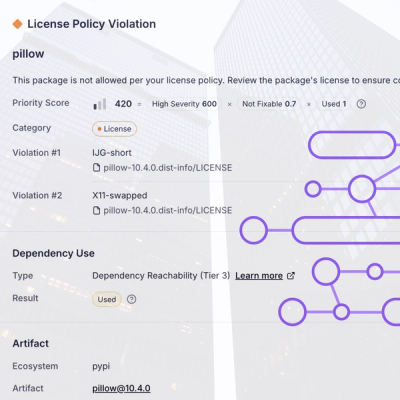
Research
/Security News
Critical Vulnerability in NestJS Devtools: Localhost RCE via Sandbox Escape
A flawed sandbox in @nestjs/devtools-integration lets attackers run code on your machine via CSRF, leading to full Remote Code Execution (RCE).

FlaredanticFlaredantic is a Python library that simplifies the process of creating tunnels to expose your local services to the internet. It supports both Cloudflare and Serveo tunneling services, making it a user-friendly alternative to ngrok, localtunnel, and similar tools.
While tools like ngrok are great, Flaredantic offers several advantages:
Flaredantic makes it dead simple to use tunnels in your Python projects!
pip install flaredantic
After installation, you can use either the CLI command flare or the Python API.
The simplest way to create a tunnel is using the CLI:
# Basic usage with Cloudflare (default) - expose port 8080 with verbose output
flare --port 8080 -v
# Use Serveo tunnel instead
flare --port 8080 --tunnel serveo
# TCP forwarding with Serveo
flare --port 5432 --tcp
CLI Options:
-p, --port Local port to expose (required)
-t, --timeout Tunnel start timeout in seconds (default: 30)
-v, --verbose Show detailed progress output
--tunnel Tunnel provider to use [cloudflare, serveo] (default: cloudflare)
--tcp Use Serveo with TCP forwarding (overrides --tunnel)
from flaredantic import FlareTunnel, FlareConfig
# Create a tunnel for your local server running on port 8000
config = FlareConfig(port=8080)
with FlareTunnel(config) as tunnel:
print(f"Your service is available at: {tunnel.tunnel_url}")
# Your application code here
input("Press Enter to stop the tunnel...")
from flaredantic.tunnel.serveo import ServeoTunnel, ServeoConfig
# Create a tunnel using Serveo
config = ServeoConfig(port=8080)
with ServeoTunnel(config) as tunnel:
print(f"Your service is available at: {tunnel.tunnel_url}")
# Your application code here
input("Press Enter to stop the tunnel...")
from flaredantic.tunnel.serveo import ServeoTunnel, ServeoConfig
# Create a TCP tunnel using Serveo
config = ServeoConfig(port=5432, tcp=True)
with ServeoTunnel(config) as tunnel:
print(f"TCP tunnel available at: {tunnel.tunnel_url}")
# Your application code here
input("Press Enter to stop the tunnel...")
from flaredantic import FlareTunnel, FlareConfig
from flaredantic.tunnel.serveo import ServeoTunnel, ServeoConfig
from pathlib import Path
# Configure Cloudflare tunnel with custom settings
cloudflare_config = FlareConfig(
port=8080,
bin_dir=Path.home() / ".my-tunnels",
timeout=60,
verbose=True # Enable detailed logging
)
# Configure Serveo tunnel with custom settings
serveo_config = ServeoConfig(
port=8080,
ssh_dir=Path.home() / ".my-tunnels/ssh", # Custom SSH directory
timeout=60,
verbose=True # Enable detailed logging
)
# Create and start tunnel (choose one)
with FlareTunnel(cloudflare_config) as tunnel:
print(f"Access your service at: {tunnel.tunnel_url}")
input("Press Enter to stop the tunnel...")
from flask import Flask
from flaredantic import FlareTunnel, FlareConfig
import threading
app = Flask(__name__)
@app.route('/')
def hello():
return 'Hello, World!'
def run_tunnel():
config = FlareConfig(
port=5000,
verbose=True # Enable logging for debugging
)
with FlareTunnel(config) as tunnel:
print(f"Flask app available at: {tunnel.tunnel_url}")
app.run(port=5000)
if __name__ == '__main__':
threading.Thread(target=run_tunnel).start()
| Option | Type | Default | Description |
|---|---|---|---|
| port | int | Required | Local port to expose |
| bin_dir | Path | ~/.flaredantic | Directory for cloudflared binary |
| timeout | int | 30 | Tunnel start timeout in seconds |
| verbose | bool | False | Show detailed progress and debug output |
| Option | Type | Default | Description |
|---|---|---|---|
| port | int | Required | Local port to expose |
| ssh_dir | Path | ~/.flaredantic/ssh | Directory for SSH configuration |
| timeout | int | 30 | Tunnel start timeout in seconds |
| verbose | bool | False | Show detailed progress and debug output |
| tcp | bool | False | Enable TCP forwarding instead of HTTP |
❗️Note: Serveo servers might occasionally be unavailable as they are a free service. Flaredantic automatically detects when Serveo is down and provides a clear error message. Consider using Cloudflare tunnels if you need guaranteed availability.
For more detailed examples and use cases, check out our examples:
FAQs
A Python library for creating free Cloudflare tunnels with ease
We found that flaredantic demonstrated a healthy version release cadence and project activity because the last version was released less than a year ago. It has 1 open source maintainer collaborating on the project.
Did you know?

Socket for GitHub automatically highlights issues in each pull request and monitors the health of all your open source dependencies. Discover the contents of your packages and block harmful activity before you install or update your dependencies.

Research
/Security News
A flawed sandbox in @nestjs/devtools-integration lets attackers run code on your machine via CSRF, leading to full Remote Code Execution (RCE).

Product
Customize license detection with Socket’s new license overlays: gain control, reduce noise, and handle edge cases with precision.

Product
Socket now supports Rust and Cargo, offering package search for all users and experimental SBOM generation for enterprise projects.